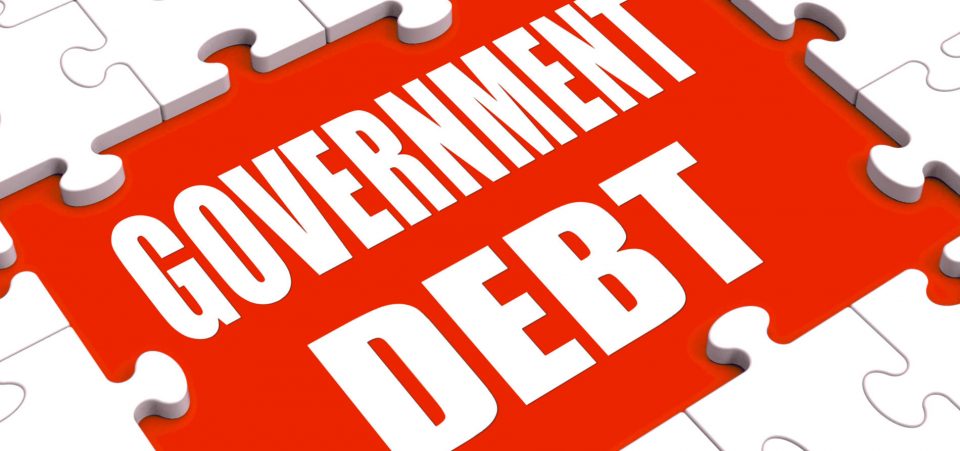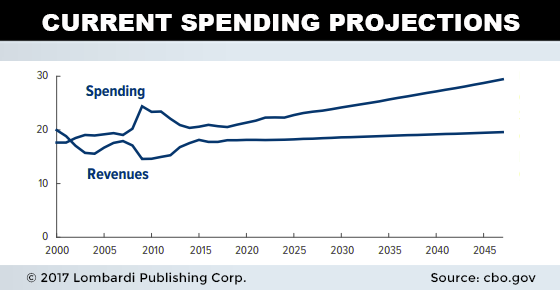Fiscal Crisis Underway
The U.S. economy is sputtering, and both the U.S. debt and deficits are going to soar in the coming years if government spending continues at its current pace–all of which will undermine U.S. economic growth. At least, that’s according to the non-partisan Congressional Budget Office (CBO).
The CBO believes that the debt-to-gross domestic product (GDP) ratio will hit 89% in 2027, 113% in 2037, and 150% by 2047. That’s a huge increase from the total current debt held by the public, $14.3 trillion, which is 77% of gross domestic product (GDP). And it will exceed the record 106% debt-to-GDP ratio in 1946. (Source: “The 2017 Long-Term Budget Outlook,” Congressional Budget Office, March 30, 2017.)
This is also a markup from the CBO’s own projections from 2016, when it said U.S. public debt-to-GDP would advance to just 141% by 2046. According to last year’s projections, the 1946 record wouldn’t be broken until 2035.
Now, 2047 might seem like a long ways away, but these projections are based on current spending. It’s not as if we’ll wake up in 2047 and discover that the federal debt soared overnight to 150% of GDP.
The good news is, the debt-to-GDP warnings are only valid if the current levels of spending remain unchanged, which we already know will not. Unfortunately, the changes are not toward fiscal tightening.
President Donald Trump campaigned on promises to cut red tape, increase spending, and cut taxes. To meet its financial obligations, the U.S. gets most of its revenue from taxes, but it’s obviously spending more than it takes in. So we know U.S. debt is going up. The big question is, how high?
On the sunnier side, the CBO believes its debt-to-GDP ratio could range from 85% with low rates and strong growth, to 244% with weaker growth and higher rates. If the immediate history is any indicator, we’re looking at the latter not the former.
The U.S. economy has struggled for years with annual GDP growth near two percent. And the next few years do not call for strong growth of anywhere near three percent. Donald Trump may have stumped for creating an environment of sustained annual growth of four percent, but the CBO maintains that the U.S. economy will slumber along over the next few decades, averaging less than two-percent growth.
The CBO calculates debt-to-GDP based on public debt. Public debt is, as the name suggests, debt held by the public, whether through treasury bills, bonds, or notes. And the public includes households and non-financial corporations, the financial sector, and Federal Reserve banks.
The largest holders of U.S. public debt though is the rest of the world. Japan and China are the largest holders, with $1.10 trillion and $1.05 trillion, respectively. Ireland is the third-largest holder with $293.7 billion. (Source: “Major Foreign Holders Of Treasury Securities,” U.S. Department of the Treasury, last accessed March 29, 2017.)
Total U.S. debt, which is what most people are more used to seeing in the headlines, is at an eye-watering $19.85 trillion.
The debt-to-GDP level is at 106.73%, the second-highest level in U.S. history. After World War II, it peaked at 121.70%. In 1988, it only equaled half of the country’s economic output.
Rising Deficits
You can’t have one without the other. In addition to soaring public and total debt, the CBO expects the deficit to triple from 2.9% of GDP this year to 9.8% in 2047. Barack Obama handed Donald Trump a deficit of $587.0 billion.
Rising deficits are bad because the government will need to borrow more money to cover expenses that exceed revenue. Borrowing money at a time when interest rates are on the rise will exacerbate the debt burden. The U.S. Federal Reserve has kept interest rates artificially low for almost 10 years, but it has recently started to raise its key lending rate.
In December 2015, it raised its rates for the first time in nearly a decade. In December 2016, it raised rates another quarter point, and in March, raised them again. The increases may be small, but they add up, and could have severe consequences for the U.S. economy. In fact, the CBO says rising interest rates is one of the main culprits for the rising debt burden.
Rising Interest Rates Will Slay Economic Growth
Increasing borrowing costs for businesses, individuals, and the government can’t help but undermine U.S. economic growth, especially in a slow-growth environment. The CBO predicts that by 2046, interest costs will be more than double what the U.S. government historically spends on research and development (R&D), non-defense infrastructure, and education combined. (Source: “CBO: Long-Term Budget Outlook Worse Than Last Year,” Peter G. Peterson Foundation, July 12, 2016.)
To get the public debt and deficits in line, the CBO recommends that the U.S. government cut spending and increase revenue. But that’s the opposite of what we’re seeing. Again, in an effort to juice corporate earnings and jolt the U.S. economy, President Trump wants to cut taxes and increase spending.
The Federal Reserve obviously thinks that the U.S. economy is on stable ground and can support measured rate hikes in 2017 and 2018. While most believe that the Fed will raise rates two more times in 2017, some at the Fed don’t think that’s fast enough.
Boston Federal Reserve President Eric Rosengren thinks the Fed should be a lot more aggressive with rising interest rates, and he believes that four hikes in 2017 are appropriate. As we have seen though, rising interest rates prematurely can have serious consequences when it comes to economic growth and the stock market. (Source: “Fed’s Rosengren Says There Should Be Four Rate Hikes in 2017,” Bloomberg, March 29, 2017.)
In December 2015, the Fed raised its key lending rate for the first time in a decade. The markets didn’t think the U.S. economy was strong enough, and stocks tanked. In December 2016, the Fed raised rates again, for just the second time in a decade. The U.S. economy wasn’t ready for that hike either, but Wall Street and Main Street were so optimistic about Trump’s pro-growth strategies that nothing could derail the party. That courtesy will only last so long though. Investors and consumers will want to see results. And they’re not yet. Since the Fed raised rates in March, the stock markets have been wavering.
Premature rate hikes in 2017 and 2018 could bring the fragile U.S. economy to a standstill, which would bring an end to the significantly overvalued bull market.
2047 is 30 years away, but the here and now is just as frightening. One just has to wonder why the CBO is warning of an imminent fiscal crisis now that Donald Trump is president, and didn’t when it was actually soaring under Obama.








